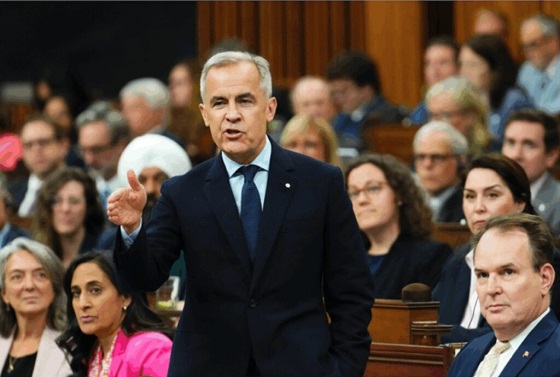Energy
Biden Talks Tough About NATO, but His Energy Policies Tell Different Story

From Heartland Daily News
By Steven Bucci of the Daily Signal
That faction must decide which is the priority: stopping Putin and helping our friends in Europe permanently leave the sway of Russia’s energy extortion, or crippling American energy companies to virtue-signal how “green” America can become. You can’t really have both.
President Joe Biden, host of the 75th anniversary NATO Summit in Washington that ends Thursday, last week claimed to ABC News anchor George Stephanopoulos that he “put NATO together.”
Trying to find a charitable spin on this claim, let’s assume Biden means that he helped NATO stand stronger against Russian President Vladimir Putin in the crisis over Russia’s 2022 invasion of Ukraine.
Biden certainly didn’t put together NATO, founded in 1949, regardless of his recollection. In that context, it makes one wonder about the purpose and intent behind Biden’s energy policies and their implications for our NATO allies.
The president’s words imply one thing, but his actions are exactly the opposite. At this week’s NATO Summit, America’s allies should have denounced Biden’s energy policies for benefiting Russia.
For example, if we investigate the Biden administration’s policies on liquefied natural gas, we find that rather than supporting NATO against Russia, they clearly enable Russia and disadvantage our allies. Biden’s imposition this year of an export moratorium on liquefied natural gas, or LNG, has hampered U.S. companies that are trying to aid our allies by weaning them off dependence on Russian natural gas.
You can debate Biden’s words (and his faulty memory), but his policies are simply dead wrong.
First, let’s look at Biden’s disastrous pause in exports of liquefied natural gas. The Energy Department has stopped new permits for such exports to Europe and Asia, which has led to price volatility and no assurance of reliable sources for our allies to meet their energy demands.
A federal judge in Louisiana recently reversed Biden’s moratorium. That action could eventually help allow private sector companies in the U.S. to support our allies in Europe and Ukraine.
One example of note includes Ukraine and Venture Global, an American company that wants to come to the rescue by supplying Ukraine and Europe with liquefied natural gas to help them reduce their dependence on Russian gas. Biden’s continued pause had stood in the way.
The judge in Louisiana noted that the Biden administration’s suspension of LNG exports conflicts with settled law such as the Natural Gas Act, which directs the Energy Department to “ensure expeditious completion” of permit reviews.
Biden’s LNG export moratorium also violates the Administrative Procedure Act, since there never was a congressional direction that the Energy Department impose it.
All of this is a clear conflict (again) between responsible policy and the extremist green faction of Biden’s Democratic Party and his administration. That faction must decide which is the priority: stopping Putin and helping our friends in Europe permanently leave the sway of Russia’s energy extortion, or crippling American energy companies to virtue-signal how “green” America can become.
You can’t really have both. And yet, ironically, new evidence demonstrates that U.S. exports of liquefied natural gas represent a climate-conscious solution. A recent Berkeley Research Group report found that these exports result in lower greenhouse gas emissions than does natural gas supplied by competing countries, and much lower emissions compared with coal.
The second example of this dangerous conflict is Biden’s support for a Middle East pipeline owned by the Russians. Here at least the president’s position seems to be nuanced, since a greater supply of oil could help lower energy prices.
Biden’s State Department has strongly supported restarting an oil pipeline that has been offline because of a political dispute among Kurdistan, Iran, and Turkey. Unfortunately, the pipeline is 60% owned by Rosneft, an oil company that itself is owned by the Russian state.
Oh, and a point I skipped above: We shouldn’t be helping Iran or a hostile Turkey to control or influence significant energy in any way. All this defies logic.
It’s obvious that Biden wants cheaper energy. Every president does in an election year. That said, why is the State Department supporting reopening a Middle East pipeline that’s majority-owned by the Kremlin after the Biden administration canceled infrastructure projects here at home?
The administration’s priorities are entirely misplaced.
There is a path forward. It involves reinforcing American leadership in domestic energy production. Instead of playing into the hands of our adversaries (Russia, Iran, and Venezuela), the Biden administration needs to change course and open more access to American oil and gas production.
That starts by permanently ending the suspension on LNG exports, ending the moratorium of oil and gas exploration on federal lands, ending unprecedented restrictions on offshore oil and gas leasing, ceasing resistance to the Canadian Enbridge Pipeline 5, and restarting canceled pipeline projects such as Keystone XL.
America’s energy resources are the envy of the world and should be leveraged to protect our citizens and our allies.
U.S. energy exports strengthen our competitive edge against China, Russia, and other hostile regimes. They also produce high-paying jobs at home and lessen dependence on any foreign source.
If America really wants to help Ukraine and be a leader in NATO, this is a path that will be consistent, effective, and inexpensive compared with direct financial or material support.
The green energy activists will hate it, but simply put: They’re wrong.
Steven Bucci is a visiting fellow in the Phillip N. Truluck Center for Leadership Development.
Originally published by The Daily Signal. Republished with permission.
Energy
Liberals Twisted Themselves Into Pretzels Over Their Own Pipeline MOU

From Energy Now
By Margareta Dovgal
Playing politics with pipelines is a time-honored Canadian tradition. Recent events in the House of Commons offered a delightful twist on the genre.
The Conservatives introduced a motion quoting the Liberals’ own pipeline promises laid out in the Memorandum of Understanding (MOU) with Alberta, nearly verbatim. The Liberals, true to form, killed it 196–139 with enthusiastic help from the NDP, Bloc, and Greens.
We all knew how this would end. Opposition motions like this never pass; no government, especially not one led by Mark Carney, is going to let the opposition dictate the agenda. There’s not much use feigning outrage that the Liberals voted it down. The more entertaining angle has been watching closely as Liberal MPs twist themselves into pretzels explaining why they had to vote “no” on a motion that cheers on a project they claim to support in principle.
Liberal MP Corey Hogan dismissed the motion as “game-playing” designed to “poke at people”.
And he’s absolutely right to call it a “trap” for the Liberals. But traps only work when you walk into them.
Indigenous Services Minister Mandy Gull-Masty deemed the motion an “immature waste of parliamentary time” and “clearly an insult towards Indigenous Peoples” because it didn’t include every clause of the original agreement. Energy Minister Tim Hodgson decried it as a “cynical ploy to divide us” that “cherry-picked” the MOU.
Yet the prize for the most tortured metaphor goes to the prime minister himself. Defending his vote against his own pipeline promise, Carney lectured the House that “you have to eat the entire meal, not just the appetizer.”
It’s a clever line, and it also reveals the problem. The “meal” Carney is serving is stuffed with conditions. Environmental targets or meaningful engagement with Indigenous communities aren’t unrealistic asks. A crippling industrial carbon price as a precondition might be though.
But the prime minister has already said the quiet part out loud.
Speaking in the House a few weeks ago, Carney admitted that the agreement creates “necessary conditions, but not sufficient conditions,” before explicitly stating: “We believe the government of British Columbia has to agree.”
There is the poison pill. Handing a de facto veto to a provincial government that has spent years fighting oil infrastructure is neither constitutionally required nor politically likely. Elevating B.C.’s “agreement” to a condition, which is something the MOU text itself carefully avoids doing, means that Carney has made his own “meal” effectively inedible.
Hodgson’s repeated emphasis that the Liberal caucus supports “the entire MOU, the entire MOU” only reinforces this theory.
This entire episode forces us to ask whether the MOU is a real plan to build a pipeline, or just a national unity play designed to cool down the separatist temperature in Alberta. My sense is that Ottawa knew they had to throw a bone to Premier Danielle Smith because the threat of the sovereignty movement is gaining real traction. But you can’t just create the pretense of negotiation to buy time.
With the MOU getting Smith boo’ed at her own party’s convention by the separatists, it’s debatable whether that bone was even an effective one to throw.
There is a way. The federal government has the jurisdiction. If they really wanted to, they could just do it, provided the duty to consult with and accommodate Indigenous peoples was satisfied. Keep in mind: no reasonable interpretation equates Section 35 of the Charter to a veto.
Instead, the MOU is baked with so many conditions that the Liberals have effectively laid the groundwork for how they’re going to fail.
With overly-hedged, rather cryptic messaging, Liberals have themselves given considerable weight to a cynical theory, that the MOU is a stalling tactic, not a foundation to get more Canadian oil to the markets it’s needed in. Maybe Hodgson is telling the truth, and caucus is unified because the radicals are satisfied that “the entire MOU” ensures that a new oil pipeline will never reach tidewater through BC.
So, hats off to the legislative affairs strategists in the Conservative caucus. The real test of Carney’s political power continues: can he force a caucus that prefers fantasy economics into a mold of economic literacy to deliver on the vision Canadians signed off on? Or will he be hamstrung trying to appease the radicals from within?
Margareta Dovgal is managing director of Resource Works Society.
Daily Caller
Paris Climate Deal Now Decade-Old Disaster


From the Daily Caller News Foundation
By Steve Milloy
The Paris Climate Accord was adopted 10 years ago this week. It’s been a decade of disaster that President Donald Trump is rightly trying again to end.
The stated purpose of the agreement was for countries to voluntarily cut emissions to avoid the average global temperature exceeding the (guessed at) pre-industrial temperature by 3.6°F (2°C) and preferably 2.7°F (1.5°C).
Since December 2015, the world spent an estimated $10 trillion trying to achieve the Paris goals. What has been accomplished? Instead of reducing global emissions, they have increased about 12 percent. While the increase in emissions is actually a good thing for the environment and humanity, spending $10 trillion in a failed effort to cut emissions just underscores the agreement’s waste, fraud and abuse.
As a nonprofit, we are dependent on the generosity of our readers.
Please consider making a small donation of any amount here.
Thank you!
But wasting $10 trillion is only the tip of the iceberg.
The effort to cut emissions was largely based on forcing industrial countries to replace their tried-and-true fossil fuel-based energy systems with not-ready-for-prime-time wind, solar and battery-based systems. This forced transition has driven up energy costs and made energy systems less reliable. The result of that has been economy-crippling deindustrialization in former powerhouses of Germany and Britain.
And it gets worse.
European nations imagined they could reduce their carbon footprint by outsourcing their coal and natural gas needs to Russia. That outsourcing enriched Russia and made the European economy dependent on Russia for energy. That vulnerability, in turn, and a weak President Joe Biden encouraged Vladimir Putin to invade Ukraine.
The result of that has been more than one million killed and wounded, the mass destruction of Ukraine worth more than $500 billion so far and the inestimable cost of global destabilization. Europe will have to spend hundreds of billions more on defense, and U.S. taxpayers have been forced to spend hundreds of billions on arms for Ukraine. Putin has even raised the specter of using nuclear weapons.
President Barack Obama unconstitutionally tried to impose the Paris agreement on the U.S. as an Executive agreement rather than a treaty ratified by the U.S. Senate. Although Trump terminated the Executive agreement during his first administration, President Joe Biden rejoined the agreement soon after taking office, pledging to double Obama’s emissions cuts pledge to 50 percent below 2005 levels by 2030.
Biden’s emissions pledge was an impetus for the 2022 Inflation Reduction Act that allocated $1.2 trillion in spending for what Trump labeled as the Green New Scam. Although Trump’s One Big Beautiful Bill Act reduced that spending by about $500 billion and he is trying to reduce it further through Executive action, much of that money was used in an effort to buy the 2024 election for Democrats. The rest has been and will be used to wreck our electricity grid with dangerous, national security-compromising wind, solar and battery equipment from Communists China.
Then there’s this. At the Paris climate conference in 2015, U.S. Secretary of State John Kerry stated quite clearly that emissions cuts by the U.S. and other industrial countries were meaningless and would accomplish nothing since the developing world’s emissions would be increasing.
Finally, there is the climate realism aspect to all this. After the Paris agreement was signed and despite the increase in emissions, the average global temperature declined during the years from 2016 to 2022, per NOAA data.
The super El Nino experienced during 2023-2024 caused a temporary temperature spike. La Nina conditions have now returned the average global temperature to below the 2015-2016 level, per NASA satellite data. The overarching point is that any “global warming” that occurred over the past 40 years is actually associated with the natural El Nino-La Nina cycle, not emissions.
The Paris agreement has been all pain and no gain. Moreover, there was never any need for the agreement in the first place. A big thanks to President Trump for pulling us out again.
Steve Milloy is a biostatistician and lawyer. He posts on X at @JunkScience.
-

 Alberta20 hours ago
Alberta20 hours agoDanielle Smith slams Skate Canada for stopping events in Alberta over ban on men in women’s sports
-

 Health2 days ago
Health2 days agoSaskatchewan woman approved for euthanasia urged to seek medical help in Canada rather than US
-

 Indigenous2 days ago
Indigenous2 days agoResidential school burials controversy continues to fuel wave of church arsons, new data suggests
-

 International1 day ago
International1 day agoFBI didn’t think it had cause to raid Trump but DOJ did it anyway
-

 Health2 days ago
Health2 days agoCanadian gov’t considers sharing census data on gender-confused children
-

 Crime22 hours ago
Crime22 hours agoThe Uncomfortable Demographics of Islamist Bloodshed—and Why “Islamophobia” Deflection Increases the Threat
-

 Energy1 day ago
Energy1 day agoLiberals Twisted Themselves Into Pretzels Over Their Own Pipeline MOU
-

 Business2 days ago
Business2 days agoCOP30 finally admits what resource workers already knew: prosperity and lower emissions must go hand in hand




